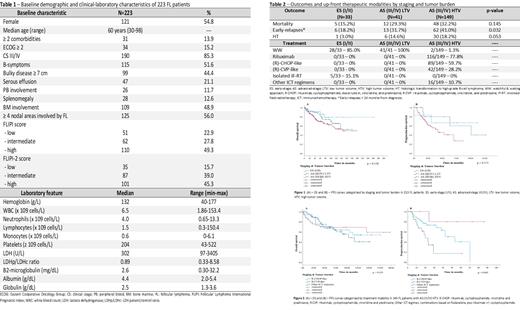Introduction: Follicular lymphoma (FL) is the most common low-grade B-cell NHL, encompassing 20-25% of all NHLs. Although classically indolent, it has heterogeneous biological behavior and variable clinical outcomes. Histologic transformation (HT) to high-grade B-cell NHL compose its natural history, being associated with dismal survival. The therapeutic management of FL and its prognosis are highly dependent on its staging and tumor burden. Based on this premise, the present study aims to describe clinical-laboratory characteristics, assess outcomes, determine predictors of survival and HT, and compare responses between different therapeutic strategies applied in a large cohort of FL patients.
Methods: This retrospective and single-center study involved 223 patients with FL grades 1-3A, diagnosed at the University of São Paulo, Brazil, from 2006 to 2022. FL patients were categorized into early-stage disease (I/II) (ES), advanced-stage (AS) (III/IV) with low tumor burden (LTV), and AS with high tumor burden (HTV) according to the GELF criteria. Endpoints included OS, PFS, early-relapse (< 24 months from diagnosis) and HT rates. Survival curves were constructed using the Kaplan-Meier method and the Log-Rank test was used to assess the relationship between variables and outcomes. Univariate analysis was performed using the Cox test and multivariate analysis by Cox regression method or proportional ratios model. The results were presented in HR and 95% CI, and a p-value ≤ 0.05 was considered statistically significant.
Results: The median age at diagnosis was 60 years (30-98) and 54.8% (121/223) were female. Approximately 15% of cases (33/223) had ES, 18.4% (41/224) had AS-LTV, and 66.8% (149/223) had AS-HTV. BM involvement, leukemic presentation, splenomegaly, and serous effusions occurred in 48.9% (109/223), 11.7% (26/223), 12.6% (28/223), and 21.1% (47/223), respectively. Bulky ≥ 7 cm, B-symptoms, ECOG ≥ 2, and involvement of ≥ 4 nodal areas were observed in 44.4% (99/223), 51.6% (115/223), 15.2% (34/223), and 56% (125/223), respectively - Table 1. Forty-nine percent of patients (110/223) were categorized as high-risk according to the FLIPI score. Table 2 summarizes the main outcomes and up-front therapeutic modalities applied in the whole cohort. With a median follow-up of 79.5 months (95% CI: 67.0-92.0) the OS medians were 18 years (95% CI: 14.9-21.1), 11 years (95% CI: 9.2-12.9), and 10.5 years (95% CI: 9.3-11.8) for ES, AS-LTV, and AS-HTV, respectively, p=0.138 Figure 1A. Similarly, the PFS medians were 6.7 years (95% CI: 3.6-9.8), 8.4 years (95% CI: 2.0-14.8), and 3.5 years (95 CI: 1.8-5.3) for ES, AS-LTV, and AS-HTV, respectively, p=0.171 Figure 1B. Early-relapses occurred in 36.3% (81/223) of cases, being 18.2% (6/33), 31.7% (13/41), and 41.0% (62/149) for ES, AS-LTV, and AS-HTV, respectively, p=0.032 Table 2. The overall mortality rate was 29.1% (65/223) for the whole cohort. HT was documented in 16.7% (37/223) of cases, being 3.0% (1/33), 14.6% (6/41) and 20.1% (30/149) for ES, AS-LTV, and AS-HTV, respectively, p=0.053 Table 2. Among patients with AS-HTV, the R-CHOP regimen did not promote increased OS compared to the R-CVP regimen (p=0.415), however it was associated with a substantial increase in PFS (p=0.005) Figure 2. Age ≥ 60 years (HR: 1.06, p<0.001), ≥ 2 comorbidities (HR: 3.85, p=0.014), B-symptoms (HR: 2.35, p=0.015), HT (HR: 2.77, p=0.002) and thrombocytopenia (HR: 2.96, p=0.028) were predictors of poor OS. Similarly, age ≥ 60 years (HR> 1.08, p<0.001), involvelment of ≥ 4 nodal areas (HR: 1.27, p<0.001), and high LDH levels (HR: 1.65, p=0.002) predicted decreased PFS. Additionally, serous effusions (HR: 2.09, p=0.05), albumin < 3.5 g/dL (HR: 2.82, p=0.05), B-symptoms (HR: 2.00, p=0.006), involvement of ≥ 4 nodal areas (HR: 1.21, p=0.014), and BM infiltration (HR: 2.11, p=0 .05) were the main predictors for HT.
Conclusion: Although it is characteristically an indolent disease, our study demonstrated that a significant portion of FL patients have shortened survival. Here, we confirmed this prognostic heterogeneity, particularly considering the clinical staging and tumor burden. Therefore, FL patients with AS-HTV had higher HT rates and early-relapses, both classic adverse prognostic markers, as well as a tendency to higher mortality. We also identified clinical and laboratory predictors for HT, which may in a near future direct adapted-risk therapeutic strategies.
Disclosures
No relevant conflicts of interest to declare.


This feature is available to Subscribers Only
Sign In or Create an Account Close Modal